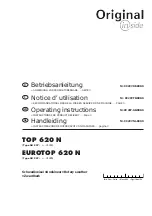
Sevcon Troubleshooting
Page 11
Electrical Troubleshooting
Test 5. CONTACTOR COIL FAULT
Disconnect the 12-pin logic card connector from the Sevcon power unit.
Turn the key switch ON and perform the following tests:
TEST 5.1:
Check the voltage on the positive coil terminal of the ISO solenoid
(violet wire).
If the voltage is within approximately 1-volt of the battery
voltage, then skip ahead to test #5.2.
If the voltage is not within approximately 1-volt of the
battery voltage, then check the diode in the positive wire
to the ISO solenoid.
Stop trouble shooting here and repair the problem. When
the repair is completed, completely retest the vehicle before
lowering the drive wheels to the ground.
TEST 5.2:
Check the voltage on the negative coil terminal of the contactor
coil.
If the voltage is not within 1-volt of battery voltage, then
the contactor is bad and must be replaced.
NOTE: An open contactor coil should be accompanied by a 4-flash
code from the logic LED.
If the voltage is within 1-volt, then one of the four
following faults may have occurred:
Broken Wire: Check the wire from pin #8 in the 12-
Stop, do not continue. Reaching this point
indicates a failure in the Sevcon power unit
or an error was made during testing. Confirm
all previous tests were performed correctly
before replacing the Sevcon power unit.
STOP
pin logic card connector to the contactor coil negative terminal for open circuits.
Welded Solenoid Contacts: Test the solenoid for welded contact tips. There are two methods
for checking the contacts:
1. Disconnect the batteries and test the continuity across the contacts. If there is
continuity then the contact tips are welded.
2. With the key switch OFF, check the voltage at the B+ terminal on the Sevcon control
(see illustration on following page). If the voltage at the B+ terminal is at full battery
voltage then the contact tips are welded.
NOTE: Welded tips should be accompanied by a 4-flash code from the logic LED.
Shorted Solenoid Coil: Disconnect the logic card connector and measure the resistance
across the solenoid coil. Depending on the solenoid or contactor you vehicle is equipped
with, the resistance should be 25 ohms or higher (nominal). A reading less than 25 ohms
may indicate a shorted coil.
The control logic may have failed.
Summary of Contents for TT-316-36
Page 2: ......
Page 6: ...TAYLOR DUNN...
Page 12: ...TAYLOR DUNN...
Page 28: ...TAYLOR DUNN...
Page 76: ...TAYLOR DUNN...
Page 82: ...TAYLOR DUNN...
Page 96: ...TAYLOR DUNN...
Page 99: ...Sevcon Troubleshooting Page 3 Electrical Troubleshooting Identifying Your Controller...
Page 120: ...TAYLOR DUNN...
Page 134: ...TAYLOR DUNN...
Page 138: ...Illustrated Parts Page 2 Front Fork...
Page 140: ...Illustrated Parts Page 4 Front Brakes...
Page 142: ...Illustrated Parts Page 6 Tilt Steering Column and Gear...
Page 146: ...Illustrated Parts Page 10 Transmission Differential Case Rear Axle...
Page 148: ...Illustrated Parts Page 12 Rear Brakes Master Cylinder 8 Brake Body...
Page 150: ...Illustrated Parts Page 14 Rear Suspension...
Page 152: ...Illustrated Parts Page 16 Motor...
Page 156: ...Illustrated Parts Page 20 Brake Lines...
Page 158: ...Illustrated Parts Page 22 Wheels and Tires Ref wheel hub 1 2 5 assembly 4 3 6 7 8 9 10...
Page 164: ...Illustrated Parts Page 28 Miscellaneous Frame and Body...
Page 168: ...Illustrated Parts Page 32 Decals...
Page 172: ...TAYLOR DUNN...
















































